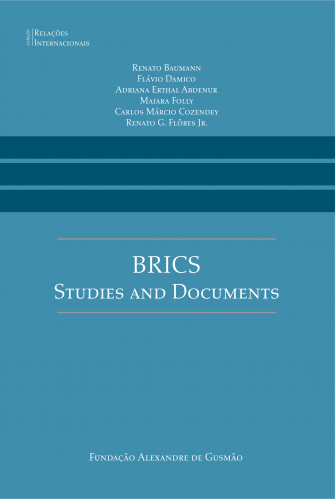
The Alexandre de Gusmão Foundation has been organizing projects to contribute to the research and debate on topics related to the international agenda of Brazil. One of these topics concerns the grouping of countries known as the BRICS (Brazil, Russia, India, China and South Africa). The Foundation’s research on this association has thus far resulted in publications such as: Brazil, BRICS and the International Agenda, and Debating BRICS. These 2013 publications arose from round-table discussions, seminars, and articles written by scholars, businessmen, diplomats, and opinion makers from Brazil and the other member-countries in the group.
Debating BRICS started the compilation of the joint statements of the annual BRICS summits that began after the ministerial meeting in Yekaterinburg, Russia, in 2008. Its goal was to facilitate a more thorough study of the subject. In 2011, FUNAG edited the BRICS Bibliographical Catalog, an unpublished work in Portuguese and English that presents a set of core readings to understand the five countries that compose the intergovernmental grouping.
The Sixth BRICS Summit, held in July 2014, in Fortaleza, Brazil, raised so much interest that a decision was made to edit a new book in order to update the analysis of the BRICS with material stemming from the latest milestone in its history: the agreements to establish the New Development Bank (NDB) and the Contingent Reserve Arrangement (CRA). These instruments are of historical importance, as they represent the very first institutions with their legal personalities created through the association’s own initiative.
Given these results, the coordinated diplomatic action of the BRICS gained greater visibility and credibility, enhanced by the consistency and scope of the economic and financial instruments that were established.
The dynamics of this evolution and the prospects that unfolded resulted in a need to update some of the Foundation’s previous publications, although they will always retain their value as sources of knowledge on the historical formation of the group and on the discussions that accompanied the proceedings. The demand for more recent analyses has been partially met by the article “VI Cúpula do BRICS: Perspectivas e Resultados” (The Sixth BRICS Summit: Perspectives and Results), written by Ambassador José Alfredo Graça Lima, which opens the first issue of Cadernos de Política Exterior (Foreign Policy Journals)1, a bi-annual publication released in 2015 by the Institute for Research on International Relations.















